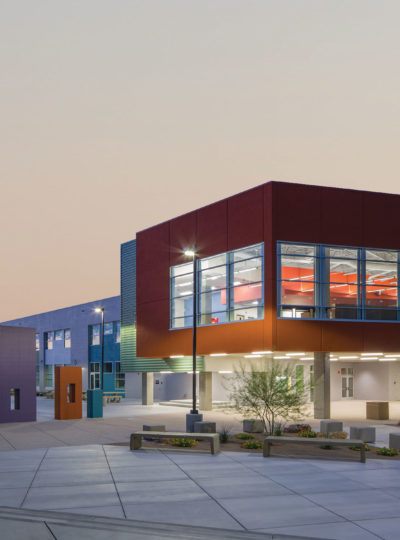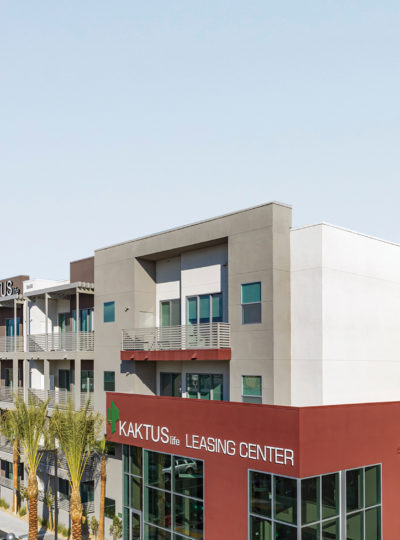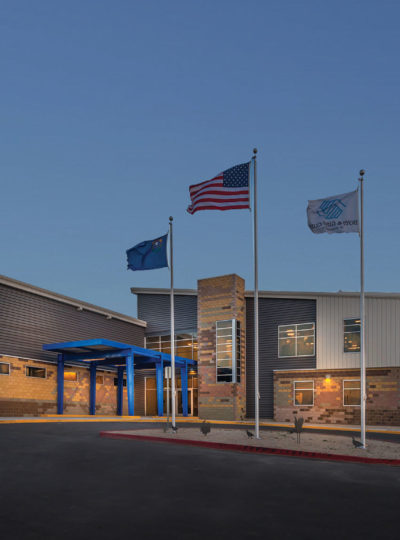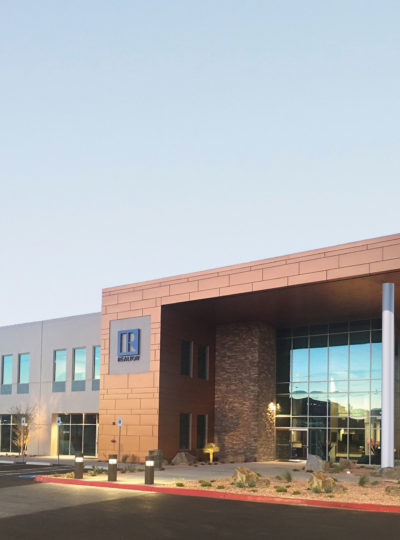Healthy Collaboration on Nevada Sciences Building
By Admin
April 27, 2021 Architecture, Community, Design, Higher Education, Learn, News, Team, Uncategorized

Recently the Betty Engelstad School of Health & Sciences at the College of Southern Nevada (CSN) in Henderson was featured in ENR Southwest. Below is the article written by Jim Parsons.
ENR Southwest | April 19, 2021 | Jim Parsons
If ever there was an appropriate time for a new health education facility to come on line, it’s during a once-in-a-century global pandemic. But as new vaccines begin turning the tide on COVID-19, the 73,039-sq-ft Betty Engelstad School of Health & Sciences at the College of Southern Nevada (CSN) in Henderson is poised to help the region handle a full gamut of health care needs for decades to come.
Set to open this fall after a six-year development process and two years of construction, the $50.2-million facility is a model of multipurpose functionality. Along with housing a 7,000-sq-ft campus library, the three-story building’s classrooms, laboratories and hospital simulation rooms will support the school’s medical and surgical assistant training curriculum as well as nearby Nevada State College’s nursing education program. Funding for the facility has come from both the state of Nevada and private donations.
“There’s a big need in the area for health care technicians, with demand for classes higher than the availability for classrooms,” says Benton Marshall, regional manager for the state of Nevada’s Public Works Division. “We needed something that allows us to fill these roles locally, rather than recruiting from out of state.”
Dennis Panars, project manager and principal for KNIT, the project architect, adds that the building aims to create a much needed sense of community for the commuter school both through its layout and close proximity to the CSN student union.
“Because students will be spending most of the day there, we programmed multiple areas throughout the building where they can come together and collaborate or find their own space to study,” Panars says. A split-level design gives the building separate entrances—the main second floor lobby faces the campus mall to the north, while the ground floor-library entrance faces the main campus parking lot to the south.
As work got underway in November 2019, “the biggest challenge was getting out of the ground,” says Jim Markichevich, site superintendent for CORE Construction of Las Vegas. In addition to a 14-ft difference between the two entrance levels, the smaller 6,759-sq-ft first-floor section required another 7 ft of depth for the elevator footings and 5-in.-thick mat slab.
“Then we had to do a big 45-degree cut about 40 feet back for the remaining foundation,” Markichevich adds. The building utilizes a slab-on-deck and steel joist support system, with concrete masonry unit walls supporting the joists in some areas.
CORE project manager Avery Hacker adds that isolated spread and continuous footings with multiple steps integrated the foundation with the elevation change. Braced structural steel frames for the building’s larger sections required footings as large as 10 ft wide and 42 in. thick, including one that required nearly 130 yd of concrete.
Overall, says Hacker, “it was kind of like building in three parts.”
Learning-oriented Layout
While the construction process became more straightforward as the building worked its way upward, the project team incorporated a number of features aimed at maximizing both space utilization and operational efficiency. According to Panars, the main lobby serves as the building’s central node, essentially separating the two schools’ academic programs, with a two-story wall of high-performance glazing providing an expansive view of the campus.
Along with a grand floating stair, the lobby also features a full-length glowing light fixture embedded in the wall designed to mimic both an electrocardiogram and the surrounding mountains. A “social” stair connecting the second floor with the library can double as a place for group presentations and events.
“There’s also a wide distribution of power and data connections so that students can work from anywhere,” Panars adds.
Building systems include four-pipe hydronic heating and cooling, lab air valve exhaust, biological safety cabinets, fume hoods and SMART classroom walls. Stacking the laboratories above each other helped consolidate mechanical system requirements while also ensuring negative air pressure and allowing for a central deionized water system. Simulation laboratories for the nurse training programs include 61 beds, including several fully functional headboards that supply medical gasses and other technology found in most hospitals.
One unique building element is the liquid linoleum flooring, a sustainable system designed to provide the same degree of durability and sound dampening without the need for heat welds. “It’s fairly new to the U.S. and a first for us, but we got up to speed on it pretty quickly,” Hacker says.
For the exterior, CORE installed nearly 13,400 sq ft of fiber cement and ultra-high-performance concrete paneling, which are complemented by decorative masonry block. Other exterior features include a three-piece, 4,290-sq-ft perforated metal screen structure on the building’s north plaza that creates a private space for students and a demonstration garden comprised of regional medicinal plants.
As with other contractors in the area, however, CORE had to adapt quickly to COVID-19 restrictions. “It seemed like the protocols changed every day,” Hacker says. “There were a lot of small delays here and there as we adjusted work to distancing requirements, but there was no big effect on the schedule.”
Hacker says the project team was always attuned to the safety considerations associated with an active campus. “Though we didn’t have any site size or access constraints, preserving a safe environment was always on our minds,” he says.
‘An Amazing Partnership’
Although no project is entirely problem free, project team members for the Health Science Building agree that construction manager at-risk delivery set the stage for a relatively smooth path toward completion.
“The process was really right for this building because of the complexity, different users and different funding sources,” observes CORE executive vice president Mark Hobaica, adding that previous collaborations with KNIT played a role as well. “Our weekly on-site project meetings are 30 minutes—that’s unheard of—and a testament to the team-wide effort to create an end-product that will be much more refined.”
Marshall agrees, though he admits to some initial skepticism about the use of CMAR delivery. “I quickly saw cohesion on the team, which was a night-and-day difference compared with other delivery methods,” he says.
Best of all, notes CSN Henderson campus provost Patty Charlton, the CMAR process yielded significant cost savings in the midst of what has been an active construction market for the region. “Having so many multibillion-dollar projects in the area heightened demand for subcontractors and materials,” Charlton says. “But we never had any labor or supply-chain issues. This has been an amazing partnership.”
As the Health Sciences Building undergoes its finishing touches and building system commissioning, Charlton looks forward to the role it will play as a catalyst for change at the campus as well as in the community.
“Even before the pandemic, health care was an important economic development driver here,” she says. “By collaborating with the state and Nevada State College on a more integrated education strategy, we are setting up a pathway from high school to both health care and the sciences. This is very much a transformative building.”





